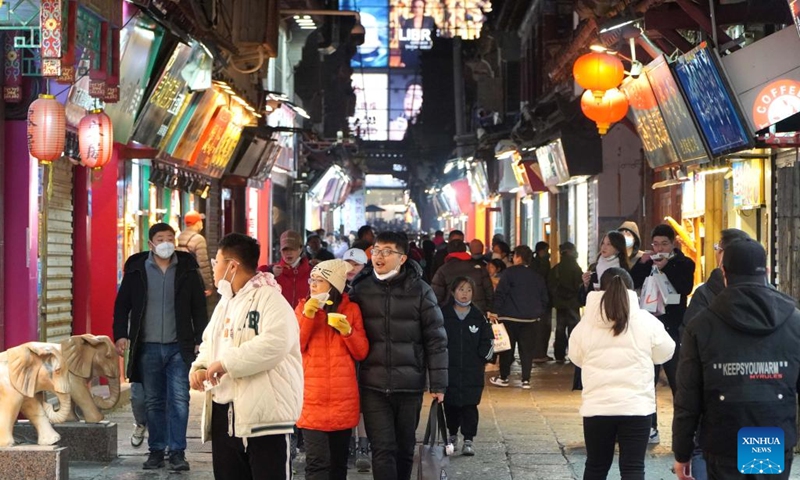China passes peaks of COVID waves
 People saunter on Furong Street in Jinan, east China's Shandong Province, Jan. 2, 2023. Furong Street, a 500-meter-long old street with more than 150 food and beverage shops, is getting back to its hustle and bustle these days.[Photo/Xinhua]
People saunter on Furong Street in Jinan, east China's Shandong Province, Jan. 2, 2023. Furong Street, a 500-meter-long old street with more than 150 food and beverage shops, is getting back to its hustle and bustle these days.[Photo/Xinhua]
With millions of Chinese people making journeys back to their hometowns in recent days, most Chinese megacities have already passed the peak of their COVID waves, some public health experts said. They also believed that the Spring Festival travel rush won't trigger a large-scale epidemic resurgence, but small-scale outbreaks in some areas, especially in remote rural areas, are highly likely as the most important holiday for Chinese people gets underway.
After megacities such as Shanghai and Guangzhou in South China's Guangdong Province announced that they have passed the peak of COVID infections, the National Health Commission (NHC) said on Thursday that provinces have already passed three peaks. Guo Yanhong, director of the medical emergency response department of the NHC, told a press conference that the number of fever clinic visits nationwide peaked on December 23, 2022 and decreased by 94 percent by January 17.
The national number of emergency department visits peaked on January 2, and decreased by 44 percent on January 17 from the peak, while the number of patients in severe conditions in hospitals peaked on January 5 and dropped 44.3 percent by January 17, Guo said.
Guangzhou authorities said on Wednesday that it has entered the final stage of the epidemic. Shanghai said on Tuesday that the city has passed the peak of infections amid ongoing COVID waves.
"We are seeing the peak of the epidemic declining now, with the numbers of urgent patients and severe cases both decreasing, and many hospitals have overcome the most severe situation of shortages of beds and medical staff," Zeng Guang, former chief epidemiologist at the Chinese Center for Disease Control and Prevention (China CDC), told the Global Times.
Currently, about 80 percent of major cities have seen the passing of infection peaks, but remote rural areas face growing challenges during the Spring Festival period as some will be hit by the infection peak sooner or later, he said.
As the main circulating coronavirus strains in China are BF.7 and BA5.2, in areas with high infection rates, the probability of being infected again within a short period of time is very small, experts said. A number of provinces and regions across China including Beijing, Chongqing, Henan and Jiangsu have reported that they have already passed the first peak of COVID-19 infections since December 2022.
 People select new year decorations at a market in Zhengding County of Shijiazhuang, north China's Hebei Province, Jan 18, 2023. [Photo/Xinhua]
People select new year decorations at a market in Zhengding County of Shijiazhuang, north China's Hebei Province, Jan 18, 2023. [Photo/Xinhua]
Chinese President Xi Jinping talked about China's COVID-19 response on Wednesday, and said the light of hope is right ahead.
"We have now entered a new phase of COVID-19 response. Tough challenges remain, but the light of hope is right in front of us. Perseverance means victory," Xi said.
Medical services nationwide have gradually returned to normal. The NHC official Guo said general outpatient clinics across the country are gradually recovering, while the proportion of COVID-19 patients in general outpatient clinics is gradually decreasing. Among the hospitalized patients, the proportion of non-COVID-19 patients hospitalized has seen a large increase, reaching 85 percent on January 17.
The inflection point of the ongoing COVID waves appeared at the beginning of January, Wang Guangfa, a respiratory expert from Peking University First Hospital, told the Global Times on Thursday. "Our major task now is enhancing the treatment of existing patients with severe illness in hospitals."
However, some experts believed that the infection waves in rural areas will last until March. Gao Fu, former head of the China CDC, was quoted as saying in media reports on Wednesday that there could be a small spike in infections from February to March when people relax their awareness of prevention and control after the Spring Festival.
As for the peak of severe illnesses amid the ongoing COVID waves, we thought that the inflection point could occur around the Spring Festival, Gao said. But now, because of the comprehensive intervention measures, it is likely to be 20 days to a month later than the peak, and the inflection point could come in early February, he added.
Thursday marked the 13th day of the chunyun period - the Spring Festival travel rush - and as of Wednesday, the total passenger trips made through rail, road, waterways and civil aviation reached 480 million, an increase of 47.1 percent year-on-year.
"I don't think there will be a large-scale resurgence of the epidemic following the Spring Festival holidays, but in some areas, small-scale outbreaks are very likely," Wang said.